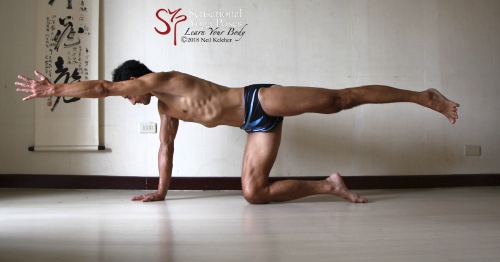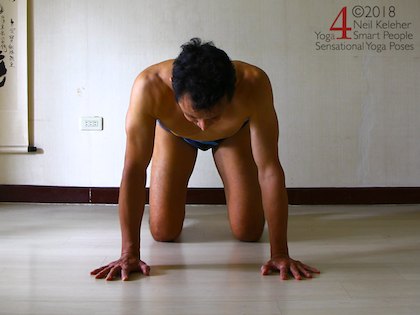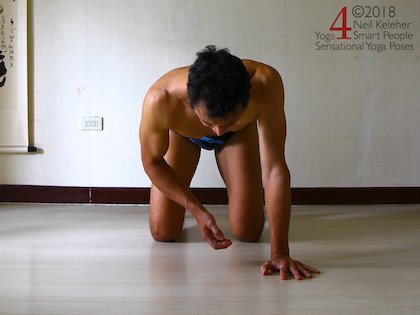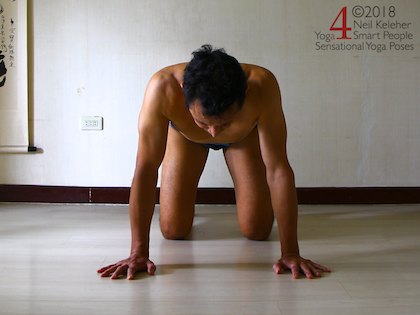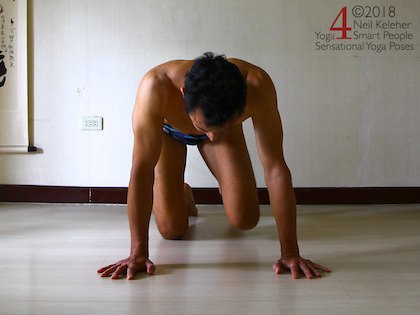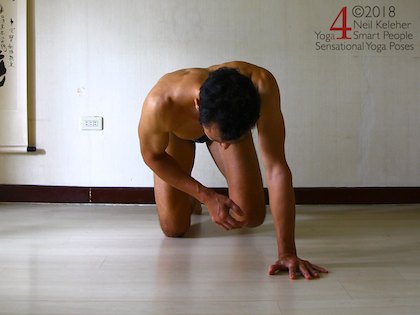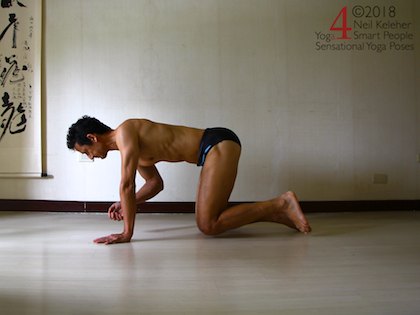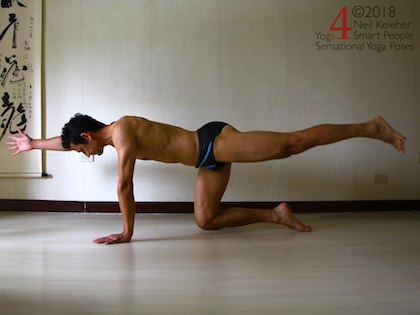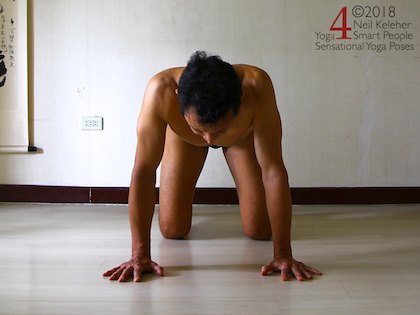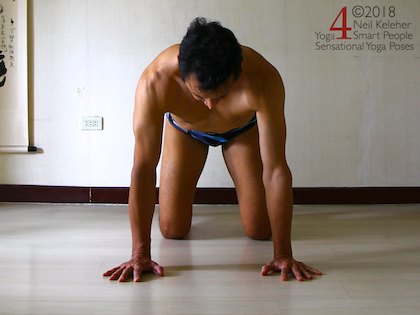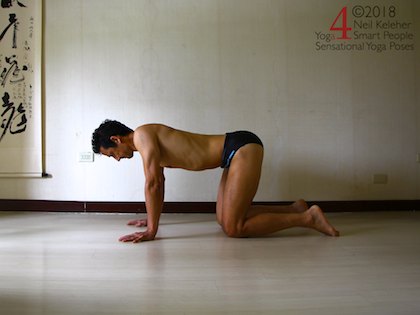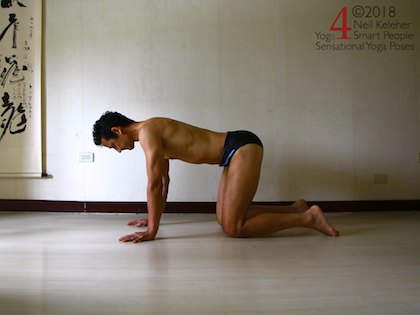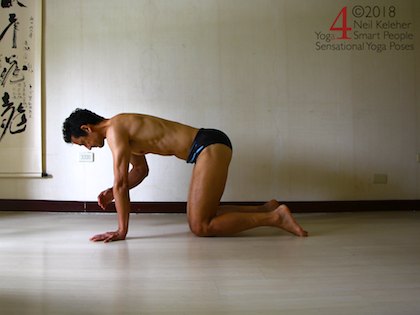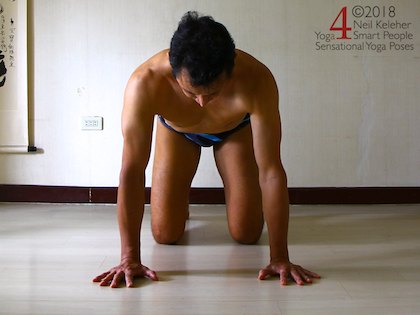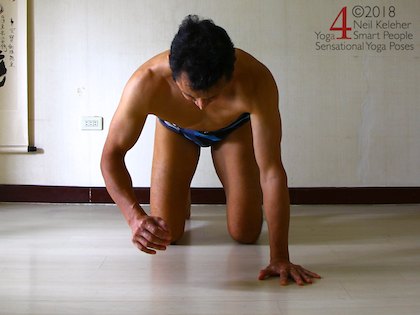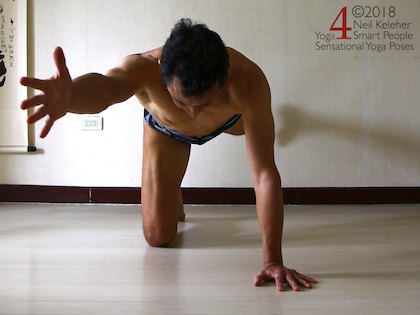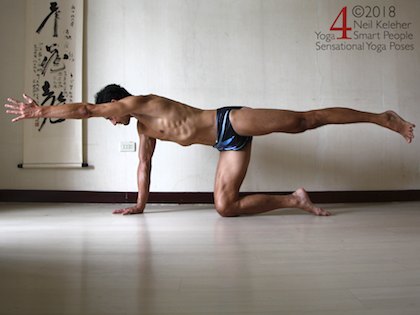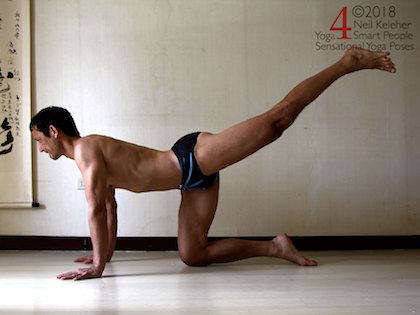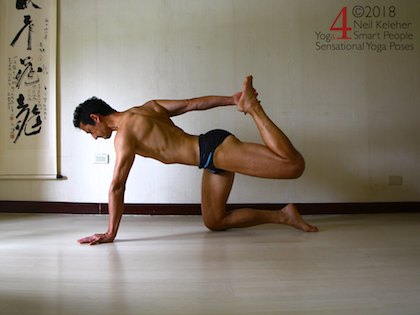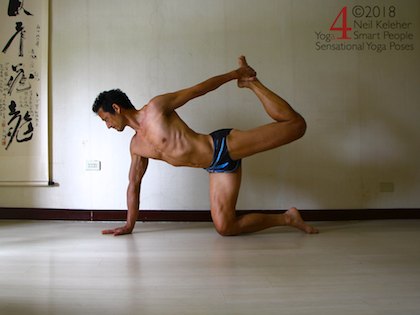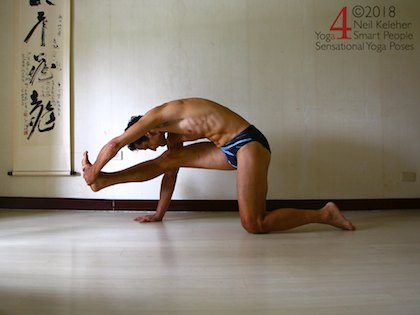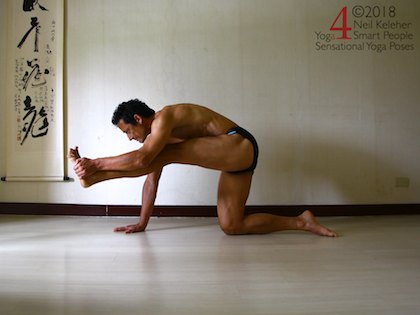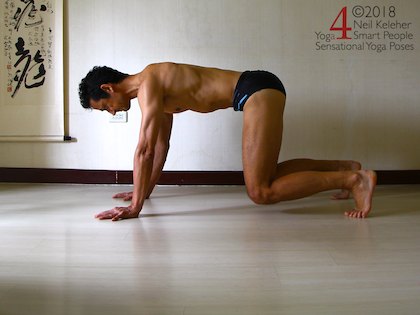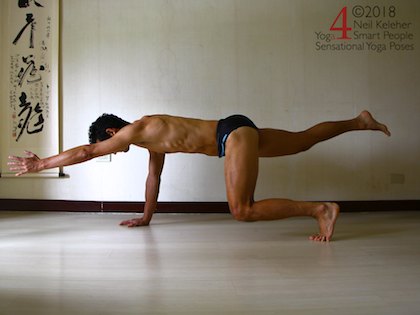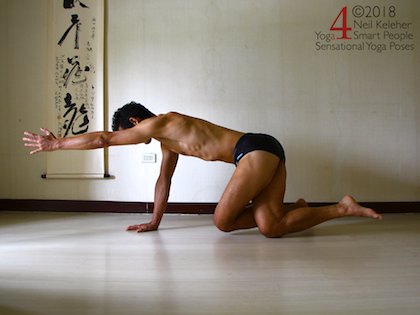Bird Dog
10 bird dog variations
Bird dog yoga pose is a simple pose for improving body awareness. There are a few different ways of doing the pose, but the more important point in all of them is that you can learn to better feel your body, control it and even understand it.
Some of these variations of bird dog are slightly easier. As a result you can focus on staying balanced.
Others are a bit more challenging, but the challenge can be one that forces you to become more aware of your body as well as forcing you to improve your body control.
The basic shape of bird dog is that you start on all fours and then lift an arm and a leg. Generally you lift the opposite arm and leg but you can also try lifting the same side arm and leg.
Basic Bird Dog
To bird dog is to pursue relentlessly.
One way you can capture that essence in the basic variations of this pose (whether same-side or opposite side hand and foot are lifted) is to make your spine long.
And then when lifting your arm and leg, make them feel long too.
A bird dog might be relentless in picking out details and in that too you can focus on feeling clearly definable parts of your body.
Is your lifted knee straight? Likewise your elbow. Are you making your fingers feel "long" (whether they are together or spread apart)?
Can you feel the hip joint of your lifted leg? For that matter, what about the hip joint of your supporting leg.
Generally, if you can feel your hip joints, that means that the muscles that work on the joint are active. And that's a good thing.
If your hip joint feels "empty", like there is a lack of tension or muscular activity, that's not so good.
If there is excessive tension in any part of your body, like a muscle is locked solid, that's not such a good thing either.
In either case you could be inhibiting the lubrication of your hip joint since that is reliant in part on muscle activation to account for the changes in force that the hip joint undergoes.
When making your spine feel long, include your sacrum as part of your spine. And so that both sides of your sacrum feel comfortable, don't be afraid to tilt your pelvis to the left or right. You can also try adjust the forwards/backwards tilt of your pelvis so that you can feel your sacrum and lumbar spine, and so that both feel comfortable.
Here again, if you can feel hip hip bones, sacrum and lumbar vertebrae,, and they feel comfortable, that's a good indication that muscles that act on these parts of the body are active.
Bird Dog Variations
Try each of the variations below a few times, before moving on to the next. If you find a variation particularly challenging you could choose to practice that variation until it becomes less of a challenge.
Basic Bird Dog
For a very basic bird dog, start of on all fours. Lift one hand and as you do so notice how your body, particularly your chest, shifts to the opposite side to compensate.
To lift your hand, try bending your elbow.
Put the hand back down and smoothly shift back to center.
Note in the first picture how my nose lines up with the gap between my legs. In the second picture my nose (and head and ribcage) have shifted slightly away from the lifted hand side.
Try the same thing with your legs. Slowly lift one leg (keep both hands on the floor for now) and notice as you do so, any tendency for your pelvis to shift towards the opposite side.
In the first picture my hips are centered over both knees. In the second picture my hips have moved towards the supporting leg side as the other leg is lifted.
Next, lift a hand, notice the ribcage shift, then lift the opposite leg.
Lift your hand and then your leg just clear off of the floor, and try to balance in that position with minimal effort.
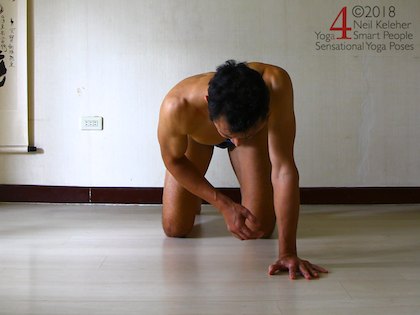
In this picture I've shifted my ribcage to lift my hand.
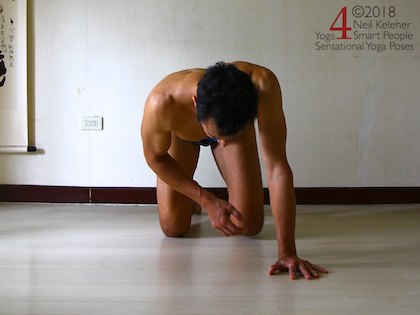
To lift my leg my hips (and ribcage) begin shifting towards the lifted arm side.
In this image leg and hand are both lifted clear off of the floor. Note how I have bended the elbow in order to lift the hand.
The idea in this variation is to make bird dog as easy as possible.
You could lift the leg first and then the opposite arm. You could also then try lifting both simultaneously.
Once comfortable with balancing with the arm and leg only slightly lifted, reach the arm forwards and the leg rearwards, and again work at staying balanced with minimal effort.
To that end, extend the arm slowly and smoothly. Extend the leg slowly and smoothly also.
Bird Dog with Protraction
You may find bird dog yoga pose a bit easier on your shoulders if you protract your shoulders first, while on all fours. Then lift an arm and a leg, keeping the shoulder of your supporting arm protracted.
If you are unused to protracting your shoulders, that can be something you practice while on all fours.
Two pictures on the left show relaxed "non-protracted" position (chest is sunk relative to shoulders). Two pictures on the right show protracted position (chest lifts as a result).
(Although it is in the context of the arm balance astavakrasana, this video has a brief demo of how to practice shoulder blade protraction while sitting upright.)
When practicing shoulder blade protraction, focus on the feeling that is created when you protract your shoulders blades and work on keeping that feeling when you lift one arm.
Work at keeping the shoulder blade of your supporting arm protracted when you lift the opposite leg also (not shown).
Bird Dog with Stabilized Torso (3 Variations)
A variation of bird dog is to work at keeping your ribcage and pelvis still after protracting your shoulder blades. So after protraction prevent any compensatory movements of your ribcage and pelvis.
Lift a hand without allowing your ribcage or pelvis to move (both knees stay down).
Then try lifting a leg without allowing your ribcage or pelvis to move (both hands stay down).
These can be exercises in and of themselves. With just the hand lifted (and the leg not reaching back) you don't have the weight of your leg to help you balance. With just the leg lifted (and kept directly behind the hip) it can be a lot of work for your midsection to support the "unbalanced" weight of your leg.
Note that these variations should be challenging.
The work is in preventing any compensatory movements of your ribcage and pelvis. As a result your muscles have to keep your body stable.
Next you can try lifting both the arm and the leg, and so that your muscles continue to have to work try reaching your hand directly ahead of your shoulder and your leg directly behind the hip.
The idea here is to prevent your arm and legs from acting as compensators so that your muscles have to work to maintain your position.
Next, try lifting the opposite hand and foot without allowing any movement of your ribcage and pelvis. Keep them still as you reach the arm forwards and the leg back.
These could count as variations. To make your butt and hamstrings work even harder, try lifting your foot higher (you can allow your pelvis to tilt forwards as you do so.)
Bird Dog with Same Side Hand And Foot Lifted
One of my favorite variations of bird dog is to lift the same side foot and hand.
- I'd suggest protracting your shoulder blades first.
- Then shift your ribcage to the supporting side so that you can lift your arm.
- Then shift your hips so that you can lift the leg.
Initially try it with the arm and leg lifted clear off of the floor (don't reach them yet.) Keep your supporting arm shoulder blade protracted.
Next try reaching the free arm forwards slowly.
Focus on feeling your supporting hand and knee as you reach your hand forwards. Any changes in hand or knee pressure will tell you if you are going out of balance. Then reach your leg rearwards, slowly.
You may find this pose easier to balance in if you press the top of your supporting foot into the floor. You can then use the top of your toes to help make balancing or staying balanced a little easier.
To make it even easier you could try positioning your foot slightly inwards so that the foot, knee and hand form an elongated triangle instead of being on the same line.
To make the pose more challenging place your hand, knee and foot on the same line. Or try lifting the foot so that only your knee and hand are in contact with the floor.
Stretching Your Hip Flexors in Bird Dog
You could use bird dog to strengthen your hip extensors and stretch your hip flexors.
As a warm up, with only your leg lifted, tilt your pelvis forwards and work at lifting your leg high while keeping the knee pointing down.
It's easy to passively bend the lumbar spine backwards when on all fours.
With your leg lifted see if you can activate your lumbar spinal erectors as well as create tension at the back of your sacrum. And feel the gluteus maximus and hamstrings of your lifted leg activating.
Whether using the same side knee and hand or the opposite to support yourself in bird dog, you could lift a hand and grab the lifted foot behind your back to stretch your hips flexors.
Here again try to activate your lumbar and sacral spinal erectors and multifidus. Use your arm and leg against each other, as if trying to pull them apart, and use the force created to help reach your leg higher.
Grabbing the opposite foot behind the back (left picture). Grabbing the same side foot behind the back (right picture).
Stretching Your Hamstrings in Bird Dog
This variation next variation isn't suitable for everybody. However, since the previous version of bird dog was used to stretch the hip flexors and perhaps even the quadriceps, the question might arise as how to do the opposite stretch using the bird dog foundation.
If you can reach the lifted leg forwards, then you can grab it with the free hand (same side or opposite side hand) and pull the leg towards the chest (with the knee straight) in order to stretch the hamstrings of that leg.
Stretching the hamstrings with he opposite hand in a bird dog variation. Stretching the hamstring of the same side leg (as the grabbing hand).
Lifting the Knee or Foot In Bird Dog
To better test your balance one way that you can vary bird dog is to lift the foot of the supporting leg so that you end up balancing on only your knee and hand.
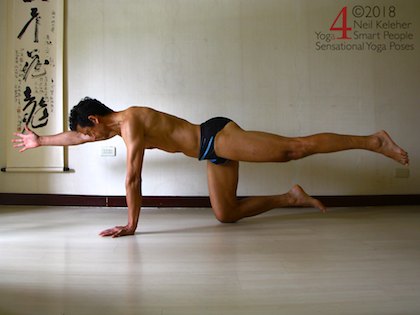
Bird Dog with foot of supporting leg lifted.
Another way to vary the pose is to lift the knee instead.
For this variation, start on all fours with the knees lifted. From here you can try lifting one foot. Then try lifting the other hand.
If you experience knee pain when trying to lift one foot then leave this variation of bird dog out.
Or work towards it gradually and intelligently, experimenting with different muscle activations to see if you can keep your knee feeling strong and safe while working towards the pose.
Using the Eagle Pose Leg Position in Bird Dog
This last variation of bird dog could be thought of as an exploration of possibility. It could be used as a substitute for eagle pose.
It could be a good way to practice balancing while dealing with the changes in sensation that crossing the legs in the manner of eagle pose causes.
If you can't get your legs in the eagle leg position then it can suffice to try to get the foot as close as possible to the shin of the other leg.
Published: 2018 04 17
Updated: 2023 01 11
